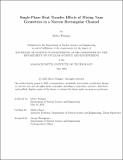Single-Phase Heat Transfer Effects of Mixing Vane Geometries in a Narrow Rectangular Channel
Author(s)
Pisinger, Mateo
DownloadThesis PDF (12.86Mb)
Advisor
Bucci, Matteo
Terms of use
Metadata
Show full item recordAbstract
Mixing vane geometries enhance the fuel-to-coolant heat transfer within nuclear reactors, which allows for more efficient use of power reactors. At the same time, their presence affects the critical heat flux (CHF), the upper limit to power produced by the reactor, within the reactor. Numerical simulations do not accurately reflect the changes to CHF when mixing vanes are included in nuclear fuel assemblies, suggesting that the CHF models are not resolving the boiling phenomena that occurs with mixing vane geometries. This thesis aims to address this gap by designing an experiment capable of directly resolving the local single- and two-phase heat transfer processes which occur when mixing vane geometries are introduced into flow channels, building on previously developed high spatial- and temporal- resolution optical and infrared imaging techniques. A high-resolution experimental database would allow researchers to understand the boiling physics at the smallest scales, enabling the creation of more advanced numerical tools for the design and safety analysis of nuclear power reactors. Single-phase heat transfer simulations using the commercial computational fluid dynamics code STAR-CCM+ were performed to aid in the design process, and a preliminary analysis of the results was conducted to identify key single-phase heat transfer phenomena. Modifications to an existing experiment were made for the inclusion of flow obstacles analogous to mixing vane geometries into a flow boiling experiment. Obstacle geometries were 3D printed using high-temperature resistant resin, allowing the creation of complex three-dimensional geometries within the experiment. Experimental validation of the simulations is needed, however, the preliminary analysis identified single-phase heat transfer phenomena of interest for further investigation. These include: the relationship between fluid velocity and turbulent kinetic energy with heat transfer; the effects of impinging flows on heat transfer; and the heat transport within and changing geometries.
Date issued
2025-05Department
Massachusetts Institute of Technology. Department of Nuclear Science and EngineeringPublisher
Massachusetts Institute of Technology